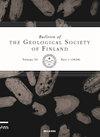Development of an ancient shoreline database to reconstruct the Litorina Sea maximum extension and the highest shoreline of the Baltic Sea basin in Finland
IF 1.3
4区 地球科学
Q2 GEOLOGY
引用次数: 44
Abstract
An ArcGIS geodatabase called the Ancient Shoreline Database (ASD) was developed for the study and interpretation of ancient shorelines and shoreline displacement information. It was further divided into the Isolation Database (ISD) and Shoreline Landform Database (SLD) based on the characteristics of the available information. In the current study, observations related to the maximum extension of the Litorina Sea and the highest shoreline in Finland were carefully recorded and classified in the ASD. A total of 1625 shoreline observations were stored in the ASD, of which 106 were stratigraphic data points from dated isolation horizons (ISD) and the remaining 1519 were data points representing morphological shoreline observations (SLD). This paper describes the content of the ASD in terms of the variability and reliability of collated data points, but also introduces how modern LiDAR-based digital elevation models were utilized in validating the published observations as well as in interpreting new data points related to ancient shorelines from areas lacking information. The compiled ASD was used to reconstruct the diachronous maximum extension of the Litorina Sea and the highest shoreline of the Baltic Sea basin in Finland.开发古海岸线数据库,重建芬兰波罗的海盆地的利托里纳海最大延伸和最高海岸线
为研究和解释古海岸线和海岸线位移信息,开发了一个名为古海岸线数据库(ASD)的ArcGIS地理数据库。根据可利用信息的特点,将其进一步划分为隔离数据库(ISD)和海岸线地貌数据库(SLD)。在目前的研究中,对芬兰利托里纳海最大延伸和最高海岸线的观测结果进行了仔细的记录和分类。ASD共存储了1625个岸线观测数据,其中106个为隔层地层数据点(ISD),其余1519个为形态岸线观测数据点(SLD)。本文从整理数据点的变异性和可靠性方面描述了ASD的内容,但也介绍了如何利用基于现代激光雷达的数字高程模型来验证已发表的观测结果,以及如何解释来自缺乏信息的地区的与古海岸线有关的新数据点。编译后的ASD用于重建芬兰里托里纳海的历时最大延伸和波罗的海盆地的最高海岸线。
本文章由计算机程序翻译,如有差异,请以英文原文为准。
求助全文
约1分钟内获得全文
求助全文
来源期刊
CiteScore
1.30
自引率
0.00%
发文量
5
审稿时长
>12 weeks
期刊介绍:
Bulletin of the Geological Society of Finland (BGSF) publishes research articles and short communications in all branches of geosciences. Contributions from outside Finland are welcome, provided that they contain material relevant to Finnish geology or are of general interest.

 求助内容:
求助内容: 应助结果提醒方式:
应助结果提醒方式:


